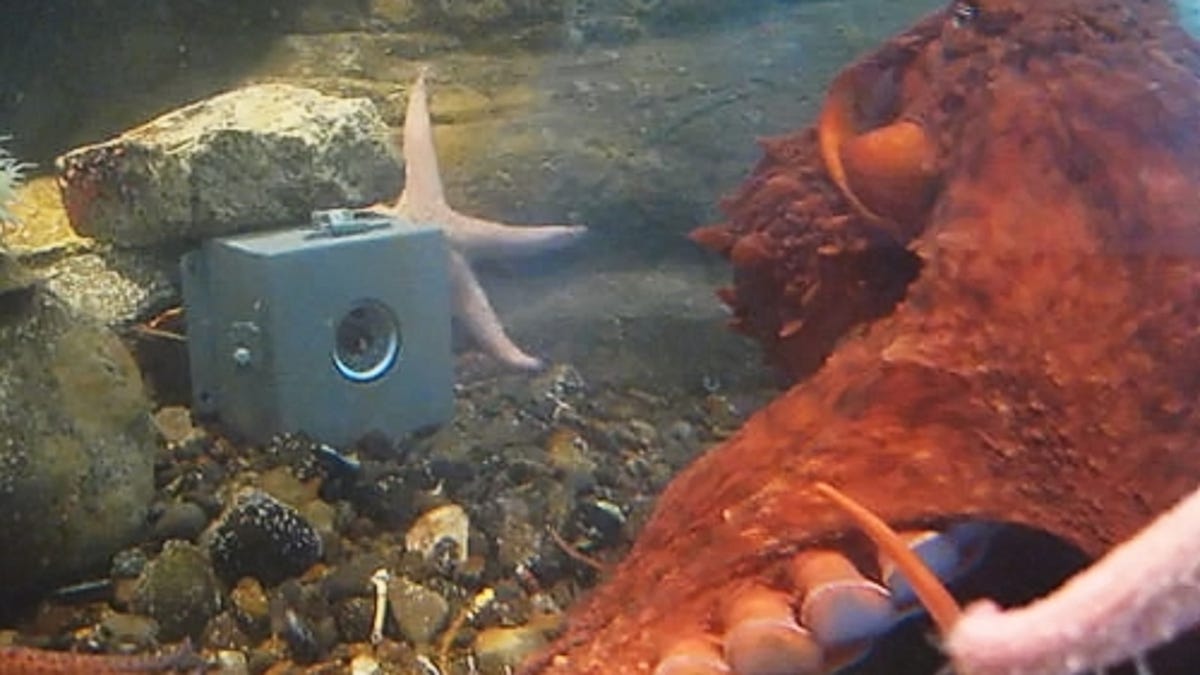OctoCam takes viewers inside the tank
Newly installed submersible Webcam allows you to be a sea star on the wall of the octopus tank at Oregon State University's Hatfield Marine Science Center.

Deriq is not your typical Internet star. He often hides out of view and one of his pastimes is taking apart his Mr. Potato Head. Perhaps the most exciting thing he does is eat--underwater.
But that's all perfectly normal behavior for the most popular resident at the visitor center at Oregon State University's Hatfield Marine Science Center in Newport. Deriq, a giant Pacific octopus, can now be seen by even bigger crowds thanks to a submersible Webcam recently installed in his tank.
The OctoCam's live 24-hour video stream takes viewers underwater and inside the octopus tank, which is also populated by sea stars and sea anemones. At first glance, all might appear to be quiet. But then the tip of a tentacle comes into view. Suddenly, more tentacles unfurl and appear to be coming straight for you, causing you instinctively to lean back just a little--even though the show isn't in 3D.
The submersible Webcam is a Lorex CVS 1000, which has infrared capability and allows images to be transmitted even when lighting is low. (The best viewing times are during the center's business hours, when the lights outside the tank are on.)
Installing the camera in the tank was no easy task. Octopuses, as you might guess, are adept at taking things apart. But the OctoCam team also had to consider how best to protect the octopus from the camera. Most of the hardware available commercially is out because it's made of metals that break down in sea water.
So the team had to design their own housing. They used a stainless-steel electrical box and applied a special marine-grade powder coating to prevent zinc contamination. Also, they smoothed all the edges of the nontoxic nylon bolts that hold the camera box together so the octopus couldn't unscrew them.
The visitor center has featured an octopus in residence going nearly all the way back to 1965, when HMSC first opened its doors. Over the years, local fisherman have donated octopuses found attached to their crab pots. The center typically will keep the creatures for about six months to a year, before releasing them back into the ocean. Deriq, who arrived at the center in January, has a body the size of a beach ball and weighs around 40 pounds; his tentacles measure about 2.5 feet long, bringing his arm span to about 5 feet. In the wild, this type of octopus averages about 110 pounds when mature.
Like many of his human counterparts living along the Pacific Coast, Deriq likes to eat crab. Feedings currently take place at 1 p.m. PDT Mondays, Thursdays, and Saturdays. Can't wait until the next feeding? Check out this video to see how an octopus cleans a crab--by turning its insides into the consistency of a milkshake.
The center has also installed a second Webcam, which allows viewers to watch visitors watching the octopus. About 80 to 100 people attend the thrice-weekly octopus feedings during the summer, according to Bill Hanshumaker, the center's public marine educator.
When the OctoCam went live last week, it proved so popular that the Media Services team had to scramble to increase server capacity. The number of unique visitors for the video feed in the first few days doubled each day, hitting 10,000 by Wednesday, according to Raul Burriel, who heads up development of the OctoCam project. The server capacity has now been increased tenfold.
Deriq is not the only underwater Internet star. The Monterey Bay Aquarium also has an underwater Webcam that takes you inside its Outer Bay and Kelp Forest exhibits, among others. You can also pay a virtual visit to the National Zoo, which has quite the collection of animal cams, including its own octopus cam, a kiwi cam, and a naked mole-rat cam (which is suitable for work).

